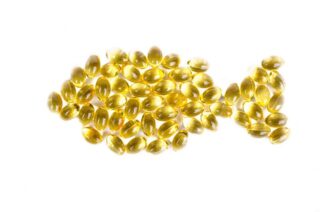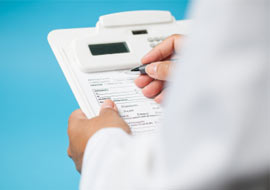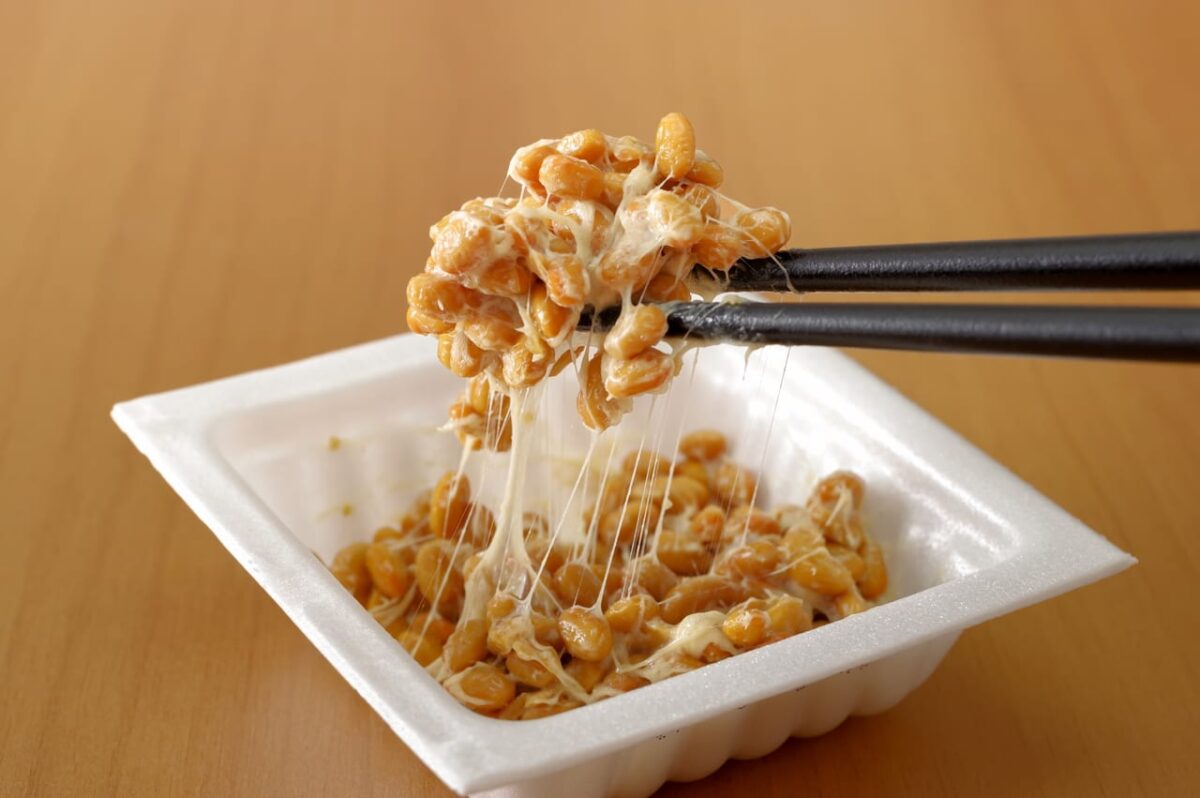Have you heard of natto? It’s a fermented soybean paste that’s popular in Japan, and it’s gaining popularity around the world as more people discover its incredible health benefits. In this blog post, we will explore five of these benefits and discuss why adding nato to your diet could have a positive impact on your health.
1. Rich in Probiotics
Natto is naturally rich in probiotics, which are beneficial bacteria that can help improve your digestive health. Probiotics can help keep the population of “good” bacteria in your gut balanced so that you can better absorb nutrients from food and fight off harmful bacteria. They can also help reduce bloating, gas, and constipation.

2. High in Protein
Natto is a great source of protein. One tablespoon contains two grams of protein. This makes it an excellent addition to any vegetarian or vegan diet, as well as for those looking to add more plant-based proteins into their daily meals.
3. Full of Vitamins, Minerals and Nattokinase
Natto is packed with vitamins and minerals like Vitamin B12, zinc, magnesium, iron, potassium, phosphorus, and calcium. Additionally, natto has been found to be high in antioxidants which can help protect against free radical damage caused by environmental factors like pollution or UV rays from sunlight.
Natto is also a great source of nattokinase, an enzyme with a variety of health benefits. This enzyme has been studied for its potential to lower blood pressure, reduce inflammation, and improve circulation. Studies have shown that it may help prevent cardiovascular diseases like stroke and heart attack as well as metabolic disorders such as diabetes.
Additionally, nattokinase has been found to have anti-cancer properties and can help boost the immune system. It can also be helpful in improving digestion by breaking down proteins and carbohydrates into smaller molecules more easily absorbed by the body.
Furthermore, nattokinase has been investigated for its ability to break down fibrin, a protein involved in clot formation, which could potentially help reduce the risk of deep vein thrombosis and other dangerous blood clots. On top of all these health benefits, scientists believe that nattokinase may even reduce the risk of developing Alzheimer’s disease due to its ability to fight against oxidative stress and inflammation in the brain. All these findings reflect why natto is such an important part of traditional Japanese cuisine today.
4. Boosts Immunity
The probiotic content of natto helps boost immunity by helping strengthen the body’s natural defense system against infections and illnesses caused by bacteria or viruses. Additionally, the Vitamin C content helps support cell growth and repair while also fighting off infection-causing microbes.

5. Improves Heart Health
Natto is low in saturated fat but high in unsaturated fats which can help improve heart health by lowering cholesterol levels and reducing inflammation throughout the body.
How to eat Natto?
Check out this youtube video on how to enjoy the most common preparation of nato. You can usually find these packs in your local asian food market. Best ways to eat Natto
Natto recipes
Conclusion
All in all, adding nato to your diet has numerous health benefits, from boosting immunity to improving heart health. All these benefits make it worth considering as part of a healthy lifestyle routine!
A healthy gut is essential for overall health. If you have been struggling with digestive issues, adding prebiotics to your diet may be the solution. Prebiotics are non-digestible fibers that feed the good bacteria in your gut and promote a healthy microbiome. Here is a list of 10 of the best prebiotic foods to add to your diet for optimal gut health.
1. Green Bananas
A green banana contains significantly more resistant starch than a yellow banana. Resistant starch is a type of dietary fiber that resists digestion and passes through the body relatively unchanged. It has been linked to beneficial effects on blood sugar, cholesterol and other markers of health.
The difference in resistant starch content between a green and yellow banana is quite significant. Green bananas contain up to four times as much resistant starch. This is because resistance starch forms before the starches in a banana ripen and convert into simple sugars.
Research suggests that eating these green bananas helps promote the growth of beneficial bacteria in your gut, reduces bloating and improves digestion.
2. Asparagus
Inulin is a type of dietary fiber found naturally occurring in asparagus and other plant-based foods.
Inulin helps to feed and promote the growth of beneficial bacteria in the gut, thereby improving digestive health. This is because it provides food for probiotics. This is necessary for maintaining the balance of good bacteria in our gastrointestinal tract.
Due to its anti-inflammatory properties, inulin helps to reduce levels of inflammation within the gut. Research has shown that consuming foods rich in inulin can help strengthen immunity and reduce susceptibility to certain illnesses.
Apart from being beneficial to our intestinal health, inulin also has various other metabolic benefits. These include: reduced blood sugar levels, improved cholesterol levels and even weight loss. All these factors make inulin a must-have for maintaining intestinal health and overall well-being.

3. Apples
Apples are a great source of prebiotics because they contain pectin Pectin is a type of fiber that feeds good bacteria in the gut and helps support regular digestion. Eating an apple with its skin on can give you an extra dose of prebiotics.
Pectin also helps to keep your digestive system moving such that food moves through at an appropriate rate. This prevents constipation and keeps the gut functioning optimally. Additionally, pectin may help to reduce inflammation in the intestines, as well as supporting healthy cholesterol levels. Research has shown that pectin can be beneficial for reducing risk factors related to both heart disease and stroke.
Finally, pectin has been found to have antimicrobial properties, helping to fight off harmful bacteria and viruses that can cause digestive upset. All in all, pectin is an essential component of maintaining optimal intestinal health and should be consumed regularly for maximum benefit.

4. Garlic
Garlic contains fructooligosaccharides (FOS) which act as prebiotics and help stimulate the growth of good bacteria in your gut. FOS can also suppress bad bacteria that can cause digestive problems like diarrhea or constipation. Additionally, garlic has antibacterial, antiviral, antifungal, and anti-inflammatory properties that help improve overall health and wellbeing.
5. Onions
Onions are another great source of FOS which can help balance out the microbiota in your gut and reduce inflammation throughout your body. They also provide antioxidants that can improve immune system functioning as well as reduce risk factors for chronic diseases such as heart disease and cancer.

6. Oats
Oats are rich in beta-glucan fiber which helps feed beneficial bacteria in the gut while improving digestion by increasing stool bulk and reducing constipation . Oats also have cholesterol lowering effects which can help reduce risk factors for heart disease.
Studies have also demonstrated that beta-glucan can help lower cholesterol levels by reducing “bad” LDL cholesterol, making it an important component of a heart healthy diet.
Additionally, reducing high cholesterol levels can help reduce risk factors associated with cardiovascular disease such as stroke, heart attack, and other chronic conditions. Finally, beta-glucan has been found to be effective in stimulating immune responses such as: increasing lymphocyte production, increasing cytokine secretion leading to better overall immunity and wellbeing. Therefore, consuming foods rich in beta-glucans is an excellent way to improve your digestive health while promoting overall well-being.

7. Barley
Barley is also an excellent source of beta-glucan fiber which helps promote good bacterial growth while aiding digestion by increasing stool bulk and reducing constipation.
8. Jerusalem Artichokes
These vegetables have long been used as a natural remedy to improve digestive health because they contain high amounts of dietary fiber known as Fructans.
Fructans are an important component of maintaining intestinal health. They are classified as a type of dietary fiber, and they can help to improve digestive issues such as bloating, gas, cramping, diarrhea, or constipation.
Fructans act as prebiotics by feeding beneficial bacteria in the gut and helping to promote the growth of microorganisms that support a healthy balance in the intestines.
Studies have even suggested that Fructans may help reduce the risk for some chronic diseases such as cardiovascular disease, Type 2 diabetes, and certain types of cancer. Furthermore, Fructans help to regulate blood glucose levels and support regular elimination of waste from the body.

9. Flaxseeds
Flaxseeds are one of nature’s richest sources of a soluble fiber known as mucilage. Mucilage is a beneficial substance for intestinal health. It is a substance created by plants as a defense mechanism, and it serves many health benefits in humans. It works as a demulcent that helps to lubricate the intestinal walls, reducing inflammation and irritation.
Mucilage provides an excellent source of soluble fiber which can help to reduce cholesterol levels, improve digestion and add bulk to stool for easier movement through the gastrointestinal tract.
In addition to helping with regularity, mucilage may also be helpful for those who suffer from irritable bowel syndrome due to its calming effect on the intestines. The fiber in mucilage helps to form a gel-like substance that binds with toxins and other waste products in the colon, preventing their re-absorption into the body. This could also potentially reduce symptoms associated with inflammatory bowel conditions such as Crohn’s disease or ulcerative colitis.
Furthermore, research suggests that consuming foods containing mucilage may have prebiotic effects, promoting good gut bacteria health. This could allow for better digestion of food and optimal absorption of vitamins and minerals into the bloodstream.
Finally, consumption of mucilage may help promote regular elimination which can reduce bloating and discomfort associated with constipation or irregularity. All these properties taken together make it clear that mucilage is an important part of maintaining optimum intestinal health and wellbeing.

10. Soybeans
Soy beans have been touted as a superfood for its many health benefits, especially when it comes to intestinal health. Studies have shown that consuming soy beans can reduce the risk of developing intestinal problems such as constipation, ulcerative colitis, and irritable bowel syndrome.
Additionally, due to its high levels of dietary fiber, soybeans can help to support healthy digestion and regularity by maintaining a balance between bacteria in the gut. The high amount of isoflavones found in soybeans helps to reduce inflammation associated with these types of conditions, while providing important antioxidants that fight off free radicals and protect against cell damage.
Those who suffer from conditions such as Crohn’s disease may find relief from their symptoms through the consumption of soybeans. Furthermore, studies have indicated that consuming foods rich in isoflavones can reduce cancer risk by inhibiting the growth of certain cancer cells. Not only are there physical benefits, but mental benefits too. Due to the presence of phytoestrogens in soybeans, they may also be able to help protect against depression and anxiety. All in all, eating soybeans on a regular basis could be beneficial in maintaining intestinal health.

Conclusion
Eating prebiotic foods is an important part of maintaining a healthy microbiome and optimizing overall health outcomes. From apples to soybeans, there are plenty of delicious options for incorporating prebiotics into your diet.
By making sure you include these 10 superfoods into your daily routine you will be giving yourself all the nutrition you need to keep your body running smoothly!
Eating healthy can be expensive. But it doesn’t have to be. With a little bit of planning and creativity, you can eat healthy without breaking the bank. Here are 10 tips to help you do just that!
1. Buy in Bulk
Buying in bulk (like at Costco or Sam’s Club) is a great way to save money on items like nuts, seeds, grains, and dried fruit. These items are often much cheaper when purchased in larger quantities than they would be if purchased from the regular grocery store. Just make sure that you’re only buying what you need so nothing goes to waste!

2. Shop Seasonally
Shopping for foods that are in season is not only more cost effective but it also ensures that your food is fresher and more nutrient dense. Shopping seasonally will also help you discover new fruits and vegetables that you may not have otherwise tried!

3. Grow Your Own Produce
Growing your own produce is a great way to save money while getting some exercise and enjoying the outdoors! Homegrown fruits and vegetables also tend to be much more flavorful than store bought produce so there’s a tasty bonus too!

4. Eat Meatless Meals
Eating vegetarian meals every now and then is an easy way to save money on groceries since meat tends to be one of the most expensive items on your grocery list. There are plenty of delicious plant-based recipes out there so you won’t get bored with your meals either! PlantUniversity.ca is a great site that will send you a meatless recipe once per week for free, check it out!

5. Meal Prep
Meal prepping saves time (and therefore money!) because it eliminates the need for last minute takeout or delivery orders when you don’t feel like cooking after a long day at work. Meal prepping also helps keep portion sizes under control which can help keep your grocery costs down as well!
6. Buy Frozen Fruits & Veggies
Frozen fruits and veggies are typically cheaper than their fresh counterparts but just as nutritious (or even more so!). Not only that but frozen fruits and veggies tend to stay fresh longer than their fresh counterparts so they won’t go bad before you get around to using them either!
7. Look for Deals & Coupons
Always look for deals or coupons when shopping for groceries as this can help lower your overall costs significantly over time. Additionally, many stores offer loyalty programs which allow customers to earn points or discounts on future purchases so make sure to take advantage of those too if possible! Save.ca is a great resource for sales and coupons.
8. Stock Up When Items Are On Sale
Stock up on non-perishable items like canned beans or rice when they go on sale since these types of products typically have long shelf lives and will last awhile before needing to be replaced again (which means more savings!).
9. Don’t Waste Food
Wasting food should always be avoided as it harms the environment in multiple ways and leads to substantial financial losses. When shopping for groceries, taking the time to plan ahead is essential in avoiding unnecessary purchases and minimising food waste. Making lists ensures that nothing gets forgotten or left behind at the store, which can then lead to a decrease in wasted food.
To further preserve food at home, one should consider storing it properly in order to keep it fresh for longer. This could involve using airtight containers for items such as grains, pulses and nuts to prevent them from going stale. Additionally, keeping track of usage-by dates is important when considering what needs to be eaten first; this will enable you to make use of food items before they go off or spoil. Freezing foods that are not likely to get eaten soon can also help extend their shelf life so they can be used later on when needed.
Finally, reducing portion size is also an effective way of preserving food. If you’re cooking too much you can always freeze the excess for another day! Taking all these measures into consideration will ensure that both environmental and financial costs associated with food waste can be minimized; while making sure that your refrigerator (and bank account) remains well-stocked! Halfyourplate.ca has some great tips on storing food.
10. Try New Recipes
Trying new recipes every now and then helps keep mealtime interesting while saving money since trying new recipes sometimes requires less ingredients than sticking with tried-and-true dishes. Who know, you might discover something delicious along the way which could become part of your regular rotation of meals moving forward too!
Conclusion
Eating healthy doesn’t mean spending a fortune; it just takes some planning ahead and looking for creative ways to save money while still enjoying nutritious meals at home with family or friends. By following these 10 tips above, everyone can enjoy eating healthy without breaking the bank!
Let’s face it, kids love snacks. From chips and candy to popcorn and ice cream, snack time can easily become the most popular meal of the day for many children. But fear not! Eating snacks all day doesn’t have to mean your child’s diet is missing out on important vitamins and minerals necessary for a healthy, balanced lifestyle. Here are some tips on how you can make sure your kids get what they need even when snacking takes center stage.
Be Smart About Snacks
It goes without saying that snacks shouldn’t be replacing meals, but if they do, there are a few things you can do to make sure they’re still providing your child with the necessary nutrition.
Whenever possible, try to opt for more nutrient-dense snacks like fruits and vegetables or whole grain crackers with cheese. Instead of chips or cookies, offer something like trail mix with nuts and dried fruit or yogurt with fresh fruit slices. This ensures that your child gets a variety of nutrients instead of just filling up on empty calories from processed foods.

Portion Control Is Key
Snacks are meant to tide us over until our next meal—not replace them! As tempting as it might be for your kid to scarf down an entire bag of chips in one sitting, it’s important to keep portions reasonable so that their stomach isn’t too full when mealtime rolls around later on. If you’re worried about them going back for second helpings throughout the day, try making smaller individual servings beforehand so that there aren’t any leftovers sitting around tempting them later on.

Get Creative & Have Fun!
Snacking doesn’t always have to be boring—it can actually be a fun way for kids (and adults) to get creative in the kitchen! Try setting aside some time each week for you and your family members to brainstorm healthy snack ideas together using ingredients from local grocery stores or farmers markets. Get creative by playing around with different food combinations and presentation techniques like cutting fruits into shapes or creating fun faces out of veggies! Not only is this a great way to bond as a family, but it also teaches kids valuable skills while helping them develop their own unique tastes in food!

Making sure the diet is balanced
To ensure your child is eating a balanced diet, it is important to take into consideration the five food groups. This includes fruits and vegetables, which should make up about one-third of the food that your child eats; proteins like lean meats, poultry, fish, eggs, beans, peas and nuts; whole grains such as oats, brown rice and quinoa; low-fat dairy products like milk and yogurt; and healthy fats such as olive oil.

Healthy packaged snacks
Healthy packaged snacks for kids can provide a great alternative to the common unhealthy snacks that are often found in the snack aisle. They can be packed with nutrients, vitamins and minerals that are essential for the growing body of young children. Many companies such as Annie’s Homegrown provide organic, gluten-free and all-natural snacks that feature a delicious combination of grains, fruits and veggies. Not only do these snacks provide balanced nutrition, but they are also yummy enough to make even the pickiest eater happy! Plus, they come in fun shapes like stars, animals and even smiley faces that kids can enjoy.
In addition to attractive packaging and tasty flavors, many healthy packaged snacks also contain wholesome ingredients such as quinoa, oats or whole grains. These ingredients have been proven to help maintain blood sugar levels in children who have diabetes or other metabolic conditions. Furthermore, some products may be fortified with extra vitamins A & D which helps support healthy bones and teeth development in kids. With more antioxidants than most other snack foods, you can feel good about providing your child with quality nutrition from these tasty treats!
Moreover, certain companies are committed to sustainability by using recyclable packaging materials and renewable energy sources to produce their goods. For instance Nature’s Bakery is one of the leading brands that strives to protect the environment while providing convenient snacks for families on-the-go. All this makes healthy packaged snacks an excellent choice for parents who want their children to eat nutritious meals with no hassle involved.

Here’s a list of 15 healthy packaged snacks for kids available on amazon:
1. Kind Bars Kids Variety Pack
2. Annie’s Organic Bunny Snacks
3. Nature’s Bakery Fruit & Grain Fig Bars
4. GoGo Squeeze Applesauce on the Go
5. Blue Diamond Nut Thins Crackers
6. KIND Kids Chewy Protein Bars
7. Stretch Island Fruit Snacks
8. Pirate’s Booty Aged White Cheddar Puffs
9. Popcorners Popped Corn Chips in Fun Flavors
10. Genuine Fruit Bites from Bare Snacks
11. Happy Kid Organics™ Strawberry Yogurt and Oats Comfort Square Bars
12. MadeGood Granola Minis Maple Quinoa Clusters
13. Terra Real Vegetable Chips in Sea Salt flavor
14. CLIF Kid ZBar Organic Oatmeal Raisin Bar
15. Gerber® Organic Yogurt Melts Mixed Berry Flavor
Conclusion
Snack time doesn’t have to mean unhealthy habits; when done right, snacking can be an enjoyable part of any healthy diet plan! By being smart about what snacks you give your kids and controlling portions accordingly, you can ensure that their diet is well balanced even when they don’t feel like eating full meals. Plus, getting creative in the kitchen is a great way to teach kids valuable skills while also having fun! So don’t be afraid to let snacks take center stage every now and again—your child’s health will thank you for it!
Do you have a child on the autism spectrum and are looking for ways to help them unlock their potential? If so, you’ve come to the right place. Believe it or not, natural treatments can make a tremendous difference when it comes to helping children with autism reach their full potential.
In this blog post, we’ll explore 10 naturopathic treatments that may provide relief from autism-related symptoms such as anxiety and social challenges. By arming yourself with knowledge about these therapies, you can find solutions tailored specifically to your child’s needs so that they can learn and grow into their best selves!
10 natural treatments for autism spectrum disorder.
Autism spectrum disorder (ASD) is a neurodevelopmental disorder characterized by difficulties with social interaction, communication, and repetitive behaviors. Some people with ASD also have sensory processing issues. Here are a number of natural treatments that can help improve the challenges associated with ASD.
1. Probiotics
Probiotics are beneficial bacteria that help support gut health. Research into probiotics and autism has revealed promising results.
In a randomized, double-blind study, children with ASD were given either active multi-strain probiotic or placebo for 12 weeks. The results demonstrated that the group taking the active probiotic had improved symptoms of autism such as increased social interaction, better communication, improved sleep habits and more positive mood.
Additionally, another study reported that when children with ASD were supplemented with specific strains of Bifidobacterium longum for four months, their symptoms associated with anxiety and depression were significantly reduced compared to those who took a placebo.
Moreover, in a study involving over 100 children with ASD and ADHD, researchers found that supplementation of Lactobacillus rhamnosus was effective in improving certain behaviors observed in these disorders. Taken together these studies demonstrate potential beneficial effects of supplementing probiotics in individuals with ASD.
2. Omega-3 fatty acids
In addition to their role in brain development and function, omega-3 fatty acids also have other potential benefits for people with ASD. Studies have shown that omega-3 supplements may improve focus, behavior, and social skills in children with ASD.
For instance, one randomized controlled trial found that children who took omega-3 supplements had better scores on tests of nonverbal communication and problem solving than those who did not. Other studies have suggested that taking omega-3 supplements can reduce irritability, depression, and anxiety symptoms in people with ASD.
Omega-3 fatty acids may also improve sleep quality in those with autism spectrum disorder. A 2020 study involving 51 participants showed that children given omega-3 supplements had improved sleep compared to those who were given a placebo. Additionally, some research suggests that taking omega-3 supplements may reduce hyperactivity levels in individuals with ASD.
Finally, there is evidence to suggest that omega-3 fatty acids may help to reduce inflammation associated with ASD symptoms. One study evaluated the effects of a fish oil supplement containing both EPA and DHA (two types of omega-3 fatty acids) on biomarkers of inflammation in adolescents and young adults with autism spectrum disorder. The results showed a significant reduction in markers of inflammation after 12 weeks of supplementation compared to baseline measurements.
Overall, the evidence suggests that omega-3 supplements may be beneficial for individuals with autism spectrum disorder by improving communication skills, reducing symptoms such as anxiety and depression, improving sleep quality, reducing hyperactivity levels, and decreasing inflammation associated with ASD symptoms.

3. Essential oils
Research has demonstrated the effectiveness of essential oils in helping to alleviate some of the symptoms associated with ASD, particularly in regards to social interaction and communication.
A study conducted by Zonfera et al (2015) found that lavender oil was effective at improving social interaction and communication in pediatric patients who had been diagnosed with ASD. The study employed a randomized trial design involving 30 children between the ages of 5 and 11. Each participant was evaluated by a team of clinicians, including psychiatrists and psychologists, before being randomly assigned to either an intervention group or control group. The intervention group received four weeks of aromatherapy sessions where they were exposed to lavender essential oil diffused via a vaporizer, while the control group received no exposure. After four weeks, participants in the intervention group showed significant improvements on measures such as verbal communication skills and overall social functioning compared to those in the control group.
A second study conducted by Hanna et al (2017) also found evidence that essential oils may be beneficial for individuals with ASD based on their findings involving lemon balm oil. This randomized clinical trial included 40 children between the ages of 6 and 12 who had been diagnosed with ASD. Participants were divided into two groups; one received lemon balm oil diffused through a vaporizer for four weeks while the other did not receive any exposure to aromatherapy treatments. At the conclusion of this study, participants who had been exposed to lemon balm oil showed improved sensory processing ability compared to those who did not receive treatment. In particular, they demonstrated better ability in responding correctly to auditory-based instructions which is indicative of improved sensory processing skill.
Overall, studies have consistently demonstrated that exposure to certain essential oils may help improve social functioning and sensory processing abilities for individuals with ASD. While further research is needed to explore more specific mechanisms behind these effects, current evidence does suggest that aromatherapy may provide some benefit for people affected by ASD when used alongside other forms of interventions such as cognitive behavior therapy and medications.

4. Music therapy
Music therapy has been widely studied in regards to its effectiveness in helping individuals with Autism Spectrum Disorder (ASD). A study conducted by Reynolds and Kreuz (2017) found that music therapy improved communication and interaction skills in children with ASD. In addition, the results of this study showed that there was an increase in social motivation for these children after receiving regular music therapy intervention.
Similarly, Darrow et al. (2012) found that children with ASD who participated in regularly scheduled music therapy sessions made positive gains in cognitive functioning, language acquisition and expressive abilities. Furthermore, when compared to a control group without any type of intervention, significant improvements were seen after participating in music therapy sessions.
In a more recent study, Berliner et al. (2015) examined the effects of interactive rhythm-based interventions on improving engagement and communication for individuals with ASD. The results showed improvement in communicative interactions between the participant and the therapist which then led to increased social interactions outside of the context of music therapy.
Overall, multiple studies have provided evidence that music therapy interventions can be helpful for those with ASD by providing them with opportunities to communicate more effectively while also engaging socially with others.
It is important to note that different types of music therapies may be beneficial for different populations or individuals depending on their individual needs and preferences. Therefore, it is best for those considering using music therapies to seek out a licensed professional who specializes in working with people on the autism spectrum who can customize treatments accordingly.

5. Magnesium
Magnesium supplementation has been linked to improvements in individuals with autism spectrum disorder (ASD). Studies have shown that magnesium plays a role in neurodevelopment, and can positively influence behaviors reported in those with ASD.
A 2017 meta-analysis of randomized, placebo-controlled trials found that magnesium supplementation reduced repetitive behaviors, hyperactivity, and irritability in individuals with ASD. Their review also showed evidence for improved sleep quality when magnesium was supplemented to children and adolescents with autism spectrum disorder. In addition to these randomized controlled trials, some open label studies suggest that adding magnesium to the diets of those with ASD can improve language abilities and socialization, compared to behavior before supplementation.
A more recent study published this year suggests that supplementing children with autism with magnesium could improve their cognition. The study reported improved scores on the Autism Treatment Evaluation Checklist (ATEC) when participants were given a combination of zinc and magnesium supplements over 10-12 weeks. There was no significant improvement noted for those given the placebo treatment instead. Additionally, results from a survey of parents suggested reduced levels of anxiety, as well as improvements in social interaction when their child had received the combination supplement treatment.
6. Massage
Massage therapy has been shown to have a wide range of benefits for people with Autism Spectrum Disorder (ASD). One interesting study in the Journal of Autism and Developmental Disorders found that massage therapy significantly improved communication and social interaction skills in children with ASD.
The study recorded the positive effects from an 8-week program of massage therapy, noting that participants were able to “establish eye contact for longer periods, initiate more conversations and become more comfortable when interacting with peers.” This is an important finding as improving these skills can help reduce anxiety in children with ASD and make it easier for them to connect with others.
Other studies have investigated the potential stress relief associated with massage therapy for people with ASD. One 2013 study examined how touch therapy through massage could aid in reducing tension and arousal levels among children with ASD. The results showed that after eight weeks of massage frequency, both tension levels and heart rate variability decreased significantly. Moreover, problems such as repetitive behaviors, self-injurious behavior, hyperactivity, emotional outbursts, physical aggression and communication difficulties were also reported to be reduced during the intervention period. Further research into this area has suggested that massage can be beneficial not only for tension relief but also for helping individuals with autism improve their sleep quality and reduce irritability levels.
In addition to its potential benefits associated with stress relief and communication skills, some studies suggest that massage may also be beneficial in improving muscle tone and managing spasticity in individuals living with autism spectrum disorder. A 2010 study published in Complementary Therapies in Clinical Practice looked at how myofascial release (MFR) could be used to improve muscle tone in children diagnosed on the autism spectrum who had significant motor coordination issues due to spasticity or hypotonia. The results showed that after 12 weeks of MFR sessions targeting specific areas of tightness or immobility, there was a significant improvement in muscle tone across all body regions tested. These findings indicate that therapeutic massage could help improve spasticity and overall mobility in individuals living with autism spectrum disorder; this could then lead to increased independence when performing activities such as walking or dressing oneself.
Overall, research shows that massage therapy has a range of potential benefits for people living with autism spectrum disorder; from improving communication skills to reducing tension levels or managing spasticity related mobility issues. As such, therapeutic massage should be considered as part of an integrated care plan when treating individuals diagnosed on the autism spectrum disorder.

7. Taurine
Taurine is an amino acid found naturally in the body and also in many foods such as meat, fish, dairy products, and eggs. Recent research has shown that supplementing with taurine may be beneficial for individuals with autism spectrum disorder (ASD).
Several studies have demonstrated that supplementation with taurine can improve communication skills, reduce repetitive behaviors, and even increase overall functioning in people on the autism spectrum.
A study from the University of California Los Angeles (UCLA) School of Medicine evaluated taurine supplementation on children aged 5 to 14 years old who were diagnosed with ASD. The results indicated that those given taurine showed significant improvements in their communication abilities and a decrease in repetitive behaviors compared to those receiving a placebo.
Another study conducted by researchers at Indiana University School of Medicine found that when a group of children with ASD were supplemented with taurine for 3 months, significant improvements were seen in symptoms such as language deficits, social impairments, and hyperactivity. These findings suggest that taurine may be an effective therapy option for managing some of the symptoms associated with ASD.
In addition to its role in reducing symptoms associated with autism, research has also suggested that supplementing with taurine can help to improve mood and reduce anxiety levels in people on the autism spectrum. A study published in Neurochemical Research found that adolescents given 500mg of taurine per day experienced a significant reduction in levels of anxiety and improved mood after only 6 months. These findings further support the potential benefits of supplementing with taurine for individuals on the autism spectrum as well as other population groups.
8. Diet
Dietary therapies have been studied as a potential treatment for autism spectrum disorder (ASD). Research has demonstrated that special diets may help improve the behavioral symptoms of ASD. For example, one study found that a gluten-free/casein-free (GFCF) diet helped reduce irritability, hyperactivity and stereotypic behavior in children with ASD.
Additionally, a recent Cochrane review concluded that there is evidence to support the use of GFCF diets and other dietary approaches to improve communication, social interaction and overall functioning for individuals with ASD.
Other studies have suggested that diets that are low in carbohydrates and high in proteins may be useful for reducing challenging behaviors in people with ASD.
Personally, I have also seen benefit in food sensitivity testing for children and adults with ASD. Food sensitivities can place an added burden of low level inflammation on individuals with ASD. Once food sensitivities are identified and eliminated improvements in social behaviors and sleep are often seen within a couple of months. For more information on food sensitivity testing click here.

9 Yoga
Studies on yoga and autism have reported promising results. A systematic review of 12 studies on yoga for various forms of autism found that it improved social behaviors, communication skills, and overall functioning in children.
Another study explored the effects of a specialized yoga program designed specifically for children with autism and found that participants showed significant improvements in mood, motor behavior, communication abilities, and overall well-being.
Researchers believe that mindful practices like yoga may be beneficial for individuals with autism spectrum disorder due to their calming effects on the body and mind. For example, a study on mindfulness-based treatments for autism spectrum disorder suggested that practicing breathing exercises and postures can reduce challenging behaviors. Additionally, research has shown that yoga helps improve focus, concentration, sensory integration abilities, communication skills, self-regulation skills, flexibility in activities of daily living (ADLs), as well as overall quality of life for those with autism spectrum disorder.
Moreover, research suggests that yoga can help improve cognitive performance by improving attention levels and reducing stress hormones such as cortisol. One study looked at the effects of a guided meditation therapy program on cognitive functions in children with autism spectrum disorder and found that those who participated experienced improved verbal memory scores and had better working memories than those who did not participate in the program.
Overall, there is an increasing body of evidence suggesting that regular practice of yoga can be beneficial for people with autism spectrum disorder in multiple ways. Practicing mindful exercises like yoga helps reduce stress levels while also providing a calming effect to both mind and body which can ultimately help enhance social interactions as well as communication skills in these individuals.
10 Mindfulness meditation
A study conducted by Sun and colleagues (2015) demonstrated the positive effects of mindfulness meditation on children with autism spectrum disorder. In this study, the participants were split into two groups: those that received mindfulness-based therapy and those that did not. The results showed that those in the mindfulness group had significantly higher levels of attentional focus than those in the control group. Furthermore, their parents reported a decrease in anxiety and depression symptoms in both groups.
Another study published by Zakaria et al. (2013) looked at the effects of mindfulness interventions on adults with autism spectrum disorder. The study found that participants who participated in the mindfulness meditation intervention reported significant improvements in overall well-being and quality of life, as well as reductions in anxiety and depression levels compared to those who did not receive the intervention.
Finally, a systematic review conducted by Sze et al. (2017) examined how mindfulness-based interventions can help improve social functioning among individuals with autism spectrum disorder. The reviewers concluded that there is evidence to suggest that mindfulness may be an effective tool for improving social functioning due to its ability to reduce stress and increase self-awareness. This may then lead to improved interactions with others, including family members and peers, which could ultimately result in more successful social relationships over time.

Naturopathic treatment for your child with autism
There is no one-size-fits-all answer when it comes to choosing the best naturopathic treatment for a child with autism. However, there are a few things to keep in mind when making this decision.
First, it’s important to consult with a qualified naturopathic doctor to get a customized treatment plan that is tailored to the needs of your child. There are many different naturopathic treatments available, and each one may be more or less effective depending on the individual child’s circumstances.
Some of the most common treatments used in naturopathy include dietary changes, supplements, homeopathy and lifestyle interventions. It’s important to work with your doctor to find the right combination of treatments for your child.
Additionally, it’s important to be patient and allow enough time for the treatments to take effect. Many children show positive results within a few months, but some may take longer depending on their individual situation.
Overall, choosing the best naturopathic treatment for a child with autism can be a complex process. However, by working closely with a qualified doctor and being patient, you can help your child achieve improved health and quality of life.
A concussion is a mild traumatic brain injury caused by a bump, jolt, or blow to the head. If you’ve been diagnosed with a concussion, you may be wondering what you should do next. This blog post will provide some helpful tips on how to manage your recovery process.
Allow Your Brain Time to Heal
First and foremost, it’s important to give your brain the time it needs to heal after sustaining a concussion. It can take anywhere from several days to several months for someone with a concussion to feel completely better. In general, most people experience symptoms for up to three weeks following the injury. During this time, it’s important that you rest both mentally and physically in order for your symptoms to improve.
Recent research has shown that the amount of rest required after a concussion to help a person heal and recover is more than what was previously thought. In order for an individual to experience the most beneficial results, it is suggested that they take at least 24 hours of rest following a concussion. This includes not only avoiding physical activity, but also limiting activities that require mental exertion and concentration, such as watching television or playing video games. It is important to note that this initial period of rest should be followed by gradually increasing activity as symptoms improve, with sufficient breaks built in throughout the day.
Additionally, studies suggest that adolescents need between 10-14 days of rest in order to achieve full recovery from a concussion. This extended period of rest could include reduced physical or cognitive activities and even temporarily stopping school or work obligations if necessary.
Ultimately, the amount of rest required after suffering a concussion will vary depending on each individual’s specific needs and symptoms. However, research has demonstrated that taking at least 24 hours of complete rest initially and then gradually increasing activity levels as symptoms improve can be an effective way for individuals to recover faster and live healthier lives.

Diet after concussion
Eating a diet that is rich in essential nutrients and vitamins can be an important part of recovery after concussion. Eating plenty of fruits, vegetables, and lean protein can help support brain health and provide the necessary nutrients to aid in neurocognitive functioning after a concussion. Studies have shown that consuming foods with omega-3 fatty acids, such as fish and nuts, may help reduce the risk of long-term cognitive impairment associated with concussions (Hoffman et al., 2015).
In addition, research suggests that eating large amounts of antioxidant-rich foods like berries, spinach, and kale can help to protect against inflammation caused by traumatic brain injuries (TBIs) (Fotuhi et al., 2016).
Furthermore, having adequate levels of vitamin D has been linked to improved outcome from TBIs (Xiao et al., 2018). Therefore it is important for individuals who have experienced concussions to consume a balanced diet that includes several servings of fruits and vegetables daily along with lean protein sources like fish or poultry. Additionally, eating smaller meals throughout the day rather than three large meals may also improve cognitive functioning after a concussion (Cantu & Nowinski, 2007).
Finally, drinking adequate amounts of water throughout the day is essential for maintaining proper hydration which helps support healing processes in the brain following traumatic injury. With these considerations in mind, dietary changes can be an invaluable tool in supporting recovery from concussion.

Exercise following concussion
Exercise can be an incredibly helpful tool for recovery after concussion. Physiotherapy or physical therapy (PT) is a common way to help individuals recover from concussions, and exercise plays an important role in this process.
Exercise has been shown to reduce symptoms of concussion such as headaches, dizziness, and difficulty concentrating (Giza et al., 2020). It can also improve overall balance and coordination, which are both key components of post-concussion recovery (Peterson & Pfister, 2020).
Additionally, exercise can help reduce anxiety and depression after concussion by providing structure and routine to each day (Roche et al., 2019). Studies have found that aerobic exercise is especially beneficial in post-concussion recovery. Aerobic exercises such as cycling or walking can increase blood flow to the brain and may also stimulate neuroplasticity in the brain cells that were affected by the concussion (Cantero et al., 2017).
By providing a safe environment with gradual increases in intensity over time, PTs are skilled at helping individuals develop an exercise plan tailored to their needs that will support their recovery. Thus, when used properly under professional guidance, exercise can be an effective tool for promoting healing after a concussion.
Sleep
Getting enough quality sleep after a concussion is one of the most important things to aid in recovery. When one suffers from head trauma, their body needs more time to heal and rest than it usually does. Without adequate rest, the healing process can be significantly delayed or slowed. Quality sleep not only allows for healing to occur but also helps individuals maintain balance, improve decision-making, and promotes physical and mental wellbeing (Liu & Ledden, 2020).
Individuals with concussions should get between seven and nine hours of quality sleep each night as recommended by the National Sleep Foundation (NSF, 2021). This amount of restful sleep may vary depending on individual circumstances.
Strategies such as avoiding caffeine after lunchtime, limiting exposure to bright screens before bedtime and establishing a regular bedtime routine can also help support recovery from concussion-related symptoms (Callaghan et al., 2019). Creating a comfortable sleeping environment free from noise, light and other distractions is important for allowing the body’s natural healing processes to occur during sleep (Freeman et al., 2017).
In addition to increasing restful sleep, individuals with concussions may benefit from engaging in activities such as yoga or mindfulness exercises that are known to reduce stress levels which can improve overall health including mental clarity (Kim et al., 2018). These activities paired with ample amounts of quality sleep may help speed up recovery time while promoting balance, improved moods and functioning following a concussion.

Supplements for concussion recovery
There are a number of dietary supplements that have been shown to assist healing after sustaining a concussion.
Omega-3
One key supplement is omega-3 fatty acids, which have been found to reduce post-concussion symptoms such as headaches and confusion, as well as helping to improve cognitive functions like memory and focus.
Studies have found that Omega-3 fatty acids can reduce inflammation of the brain, which is a primary factor in concussions and other types of traumatic brain injuries. It has also been demonstrated that Omega-3s help protect brain cells from damage caused by free radicals and oxidative stress, which are both associated with at least some forms of head trauma.
Furthermore, research has suggested that Omega-3s might help improve cognitive function and motor coordination following a concussion. In particular, studies have pointed to the potential for Omega-3s to increase the speed at which athletes return to play following a concussion. For example, one study conducted on collegiate football players found that those who took daily doses of fish oil for 2 weeks before their season had significantly less downtime due to post-concussive symptoms compared to those who did not take supplementation (Mazzuca et al., 2018).
Another randomized controlled trial showed that daily consumption of 1 gram per day of omega-3s was associated with improved memory performance post injury (Dang et al., 2016).
Collectively, these findings suggest that Omega-3 supplementation may be an effective tool for supporting recovery after concussion.

Vitamin D
A growing body of evidence indicates that supplementing with vitamin D can help to reduce the severity and duration of symptoms associated with a concussion, as well as help to improve cognitive functioning. For example, a study in the American Journal of Clinical Nutrition found that participants who supplemented with 4,000 IU of vitamin D per day for 12 weeks reported significant improvements in balance, reaction time, and tactile sensitivity compared to those who did not receive supplementation.
Additionally, a review published in the journal Sports Medicine found that supplementing with vitamin D may reduce the amount of time it takes for an individual to return to their baseline performance after suffering from a concussion. This is likely due to its neuroprotective effects and ability to reduce inflammation.
Vitamin D also appears to have beneficial effects on depression-like symptoms which can occur after a concussion. A study published in BioMed Research International found that among individuals who had suffered minor head injuries or mild TBIs, those who supplemented with vitamin D saw greater improvement in depressive symptoms than those who did not receive supplementation. Overall, these findings suggest that supplementing with vitamin D may be a beneficial adjunct treatment for aiding recovery after concussion or other mild brain injuries.
Magnesium
Magnesium supplementation has been found to be beneficial in supporting recovery after concussion. A recent systematic review of studies published in the American Journal of Medicine concluded that magnesium supplements may reduce the severity, duration, and frequency of post-concussion symptoms such as headaches, sleep disturbances, dizziness, and cognitive impairments.
In addition to reducing symptoms following a concussion, magnesium supplementation has also been shown to aid in the repair of neuronal damage caused by the trauma. For example, a study published in The Neuroscientist journal showed that magnesium was able to attenuate neuronal damage by increasing protective proteins and reducing glutamate levels in rats with traumatic brain injury (TBI).
Furthermore, a study conducted on college football players revealed that those who received magnesium supplements reported fewer concussions over a three year period than those who did not receive supplementation. This suggests that magnesium may provide some protection against concussions by increasing brain resilience and aiding in recovery after an event occurs.
While more research needs to be done in order to gain further insights into how magnesium affects the recovery process following a concussion, current evidence suggests that it is a safe and effective way to help support recovery after such an injury.
Cannabidiol
CBD has been found to be a valuable supplement for those who have sustained a concussion. Studies have shown that CBD can help reduce inflammation, which can occur after a traumatic brain injury (TBI). It can help stabilize the post-injury neurochemistry of the brain, which is often affected due to a concussion. People who use CBD after sustaining a concussion often report feeling more alert and motivated, as well as having better concentration and short-term memory. CBD is also known to decrease anxiety and depression, two common side effects of TBIs.
CBD can also help to reduce headaches and improve sleep quality, both of which are important for healing from a concussion. Furthermore, some studies suggest that CBD may even protect against future cognitive decline by preserving brain cells and protecting them from damage caused by free radicals. All in all, taking CBD following a concussion could make the healing process easier and more comfortable for those who have experienced head trauma. As with all supplements it is important to consult with your healthcare practitioner prior to use in order to know proper dosage and common side affects and interactions.

Vitamin B12
Vitamin B12 supplementation can be an effective tool for recovery after concussion, as evidence suggests that B12 deficiency may contribute to post-concussion syndrome. One study found that patients with chronic post-concussion syndrome were more likely to have lower serum B12 levels, suggesting a potential link between Vitamin B12 deficiency and the condition (Al Abed et al., 2018). B12 supplementation has also been suggested as a potential treatment for post-concussion headaches due to its anti-inflammatory properties (Lakhani et al., 2020).
Additionally, Vitamin B12 has been shown to support cognitive function by aiding in the biosynthesis of neurotransmitters, which are essential for proper brain functioning (Matthews et al., 2016).
Zinc
Zinc is an essential mineral for human health, and supplementation with zinc has been linked to faster recovery times from concussion. Evidence from a study published in the Journal of Neurotrauma suggests that zinc may improve recovery time following a concussion. In their study, researchers found that administration of zinc sulfate within 24 hours after the initial diagnosis of concussion significantly improved recovery outcomes for patients.
Another study in the journal Nutrients showed that taking high doses of zinc was associated with better cognitive performance following a mild traumatic brain injury (mTBI). This is likely due to the fact that zinc plays an important role in the structural integrity of synapses and neurons, as well as helping to reduce inflammation in the brain which can occur after concussions. Taken together, these studies suggest that supplementing with zinc can be beneficial for those who suffer from a concussion and should be strongly considered for those looking to enhance their recovery times.
Probiotics
The use of probiotic supplementation to support recovery from concussions is gaining increased recognition in the medical community. Research conducted on this topic has consistently demonstrated that probiotics may be beneficial for those recovering from mild-to-moderate traumatic brain injury (TBI).
A study published in 2017 showed that daily consumption of a probiotic supplement containing both Lactobacilli and Bifidobacteria, resulted in an improvement in cognitive functioning, including attention and verbal memory, as well as enhanced emotional regulation up to 6 months after TBI. This finding offers potential new treatment strategies for those recovery from concussion-related symptoms.
Other studies have also indicated that probiotics may be useful for patients suffering from post-concussive syndrome (PCS). In a randomized controlled trial conducted in 2018, researchers found that participants who took a multispecies probiotic supplement reported fewer PCS symptoms one month following their treatment than did those who received the placebo. Furthermore, another study showed that taking a probiotic supplement daily could reduce levels of systemic inflammation, which has been linked to longer periods of recovery time following a concussion.
Overall, there is evidence to suggest that probiotics can play an important role in supporting concussion recovery by providing neuroprotection and promoting overall health. Probiotics have been identified as having neuroprotective effects due to their ability to promote gut homeostasis and modulate neuroinflammatory processes which can help improve cognition and reduce inflammation.
While further research is needed to determine the exact mechanisms by which probiotics might support recovery following concussion, current findings suggest that this type of supplementation may be an effective adjunctive treatment option.

Curcumin
Curcumin supplementation may have a beneficial effect on recovery from concussion. This is because curcumin is a powerful antioxidant that scavenges oxidative stress and inflammation, both of which can contribute to the progression of post-concussion syndrome (PCS) symptoms. A 2019 study published in the journal Brain Impairment found that curcumin supplementation significantly reduced PCS symptoms in patients with mild traumatic brain injury when compared to placebo. The study concluded that curcumin has potential as an effective supplement for reducing PCS symptoms.
Additionally, another study published in 2020 in the European Journal of Nutrition found that curcumin improves cognitive function after experiencing a concussion due to its anti-inflammatory properties. Participants of this study experienced improved memory and attention following supplementation with curcumin over the course of six weeks.
Furthermore, another 2020 study published in Brain Injury showed that curcumin supplementation may protect against microglial activation, which is one of the leading causes of inflammation after a concussion. This suggests that by supplementing with curcumin, individuals may be able to reduce their risk for developing neuroinflammation after sustaining a concussion.
Glutamine
Glutamine supplementation may be a valuable tool to support recovery after concussion. Research has shown that glutamine supplementation can reduce cerebral edema and improve neurovascular autoregulation after concussion, as well as promote repair of damaged neurons and axons. Studies have also suggested that glutamine supplementation can reduce post-concussion symptoms such as headache, dizziness, confusion, difficulty concentrating, memory loss and fatigue.
One study reported that patients with mild traumatic brain injury who received glutamine supplements experienced faster resolution of their symptoms compared to those who did not receive supplements. Another study found that participants with moderate-to-severe traumatic brain injury who received glutamine supplements had improved cognitive performance on tests measuring attention span and working memory. Thus, glutamine supplementation can be beneficial for recovery from concussion by helping to reduce symptoms associated with injury and aiding in neurological repair processes.
Carnitine
Studies have demonstrated that the administration of the amino acid L-carnitine, in combination with traditional physical and cognitive therapy, can lead to faster and more complete recovery from concussion.
Carnitine helps to maintain the brain’s energy balance, as it helps transport fatty acids across mitochondrial membranes for energy production. This process helps support healthy neural pathways, which can help reduce the symptoms of concussion and improve overall recovery time.
Additionally, carnitine works to protect neurons from oxidative damage by stimulating antioxidant activities and increasing glutathione levels in the brain. Observational studies suggest that carnitine supplementation may also alleviate some of the long term consequences associated with concussion such as decreased concentration and memory issues.
CoQ10
Finally, Coenzyme Q10 has been found to protect brain cells from free radical damage caused by a traumatic event like a concussion, helping to speed up the healing process.
CoQ10 supplementation has been studied as a potential tool to support recovery after concussion. In one study, patients with mild traumatic brain injury were given CoQ10 for 8 weeks and demonstrated improved neurological symptoms compared to the placebo group. Specifically, the CoQ10 group reported reduced headache frequency and intensity, increased cognitive performance on a standard battery of tests, and overall reduction in disability.
In another study, patients with acute mild traumatic brain injury were supplemented with CoQ10 for 8 weeks. Participants reported statistically significant improvements in quality of life, cognition, and alertness when compared to those who received a placebo. Additionally, MRI scans performed on the subjects revealed less white matter lesions in those who had been provided CoQ10 as opposed to the control group.
CoQ10 supplementation can be used to support recovery after concussion by improving clinical scores related to cognition and disability while also helping reduce oxidative stress and inflammation associated with MTBI pathology.
All these supplements should be taken under the guidance of a healthcare provider in order to maximize their effectiveness in treating and healing a concussion.
Be Mindful of Your Symptoms
It’s important that you monitor your symptoms closely after sustaining a concussion so that if they get worse, you can seek medical help right away. Common signs and symptoms include headaches, dizziness, nausea/vomiting, sensitivity to light and noise, difficulty concentrating or remembering things, feeling tired all the time, blurred vision or double vision, slurred speech, and irritability/mood changes such as depression or anxiety. If any of these symptoms persist beyond three weeks following the injury or become severe enough interfere with daily life activities (e.g., work/school), you should contact your healthcare provider for further evaluation and treatment if necessary.

Conclusion
Recovering from a concussion can take anywhere from several days to several months. Everyone heals differently depending on individual circumstances such as age, medical history etc., so it’s important that you talk with your healthcare provider about what will be best for managing your particular situation going forward. By allowing yourself time to heal mentally and physically while being mindful of any changes in symptomotology throughout the recovery process and following all instructions provided by your healthcare provider accordingly will help ensure an optimal recovery outcome long-term!
Feeding a picky eater can be stressful and frustrating. It’s hard to know what to do when your child is constantly refusing to eat certain foods. But don’t worry there are a few simple tips and tricks you can use to make meals easier for everyone. Here are 10 tips for picky eaters that may help.
1. Involve children in meal planning and preparation
Involving your child in the cooking process can help them develop an appreciation for food, as well as an understanding of the effort involved in making a meal. This will also give them ownership over their own food choices, allowing them to decide what they’d like to eat on their own terms.

2. Offer small portions of food at first
If your child is hesitant about trying new foods, offer them smaller portions than you would typically serve so that they don’t feel overwhelmed or intimidated by the size of the plate in front of them. You can always provide them with a second helping when they finish their plate.
3. Make sure there are familiar items on the plate
Having a few familiar items on the plate (like macaroni and cheese, veggie sticks, or crackers) alongside unfamiliar ones gives kids something to rely on if they don’t take to the new item right away. this strategy makes it easier for them to take a risk and try it out without feeling uncomfortable or scared off by unfamiliarity.

4. Introduce one new food at a time
When introducing new foods, start with just one item at a time so as not to overwhelm your child with too much change all at once. Having too many new foods can be intimidating or even scary for some children (especially young ones).
5. Let children choose from two or three options when possible
Giving kids choices within reasonable parameters gives them more control over their meals without overwhelming them with too many options. This helps build trust between parent and child around food choices while also allowing kids some freedom in deciding what they’d like to eat each day/mealtime!
6. Offer healthy snacks throughout the day
Eating healthy snacks throughout the day helps maintain blood sugar levels and keeps kids from getting overly hungry during mealtimes. Doing this makes them more likely to try out new foods when presented with those same items during mealtime. Here are some great healthy snack ideas for the kiddos https://www.healthline.com/nutrition/healthy-snacks-for-kids

7. Don’t force feed
Forcing a child to eat something they don’t like can have a long-term negative effect on both the child’s development and relationship with food. It can make them feel helpless, scared and resentful. This can lead to a lack of trust in their parents, as well as the development of unhealthy habits such as overeating in the future.
Furthermore, forcing children to eat certain foods can lead to an aversion or even dislike towards those foods, which could limit a child’s diet and nutrition later on in life. Additionally, it can often lead to children eating too much at one time, which could contribute to weight problems down the line. On top of that, it may also discourage healthy eating habits as kids become more likely to prefer processed or junk foods since they’re seen as more fun or exciting than nutritious options. It would be far better for parents to encourage their children’s desire for healthy food by providing plenty of nutritious options and showing interest in what they’re eating instead of dictating what they consume.
Forcing kids to eat something they don’t want could lead to negative associations with that food item in the future. Instead, focus on offering healthy options and letting your child decide how much he/she wants of each item (within reason).
8. Use positive reinforcement
Positive reinforcement goes a long way towards helping kids learn healthier eating habits; praising good behavior (like trying out new foods) will encourage more of it in future dining experiences!
9. Take time out before meals
Taking five minutes out before meals allows both parents and children time alone together. This helps create an atmosphere conducive towards trying new things without fear of judgment or pressure from either side.

10. Talk about nutrition
Talking about nutrition doesn’t have to be boring; instead it should focus on why certain foods are beneficial (or not). This information can help form more informed decisions when it comes time for dinner!
Some simple nutritional supplements can also take some of the stress off of a period of picky eating. See my article on the top 10 supplements for kids health for more information.
Conclusion
Picky eating isn’t easy but there are ways you can make mealtimes less stressful for everyone involved. From including your children in meal planning and preparation processes all the way through offering healthy snacks throughout the day, these ten tips will help make dinnertime easier while still ensuring that your family eats nutritious meals together. If you feel that you require more counseling, feel free to book an appointment.
When it comes to testosterone, more isn’t always better. In fact, having too much testosterone can actually be just as problematic as having too little. That’s because there are different types of testosterone, each with its own unique function in the body. Here’s a quick rundown of the different types of testosterone you may see on a blood test and what they mean.
Total Testosterone:
This is the most commonly measured type of testosterone. It includes both “free” testosterone (the active form that binds to receptors and produces effects in the body) and “bound” testosterone (which is bound to sex hormone binding globulin [SHBG] and is inactive). The total testosterone test can be helpful in diagnosing conditions like low testosterone or androgen deficiency, and can also help monitor the effectiveness of treatment.

Free Testosterone:
As its name suggests, free testosterone is the “unbound” or active form of the hormone. This is one of the forms that’s available to bind to receptors and produce effects in the body. Because it’s unbound, it’s also the form that’s most easily measured in blood tests.
The percentage of free testosterone that’s considered optimal varies depending on the source. Some say that levels below 2% are indicative of low testosterone, while others recommend levels closer to 5%. Still, others claim that there’s no such thing as an “optimal” percentage. What is more important is understanding the symptoms of low testosterone in the context of blood test results.
Common symptoms of low testosterone include fatigue, low sex drive, and erectile dysfunction. It can also lead to weight gain, muscle loss, and a decrease in bone density.

Bioavailable Testosterone:
Bioavailable testosterone includes both free testosterone and “weakly bound” testosterone, which is bound to albumin (a protein in the blood). This form of testosterone is considered more biologically active than total or free testosterone because it represents the amount of hormone available to bind to receptors and produce effects in the body.
Bioavailable Testosterone = Free Testosterone + Albumin-Bound Testosterone
Sex Hormone Binding Globulin (SHBG):
SHBG is a protein that binds to testosterone and other hormones, including estrogens, dihydrotestosterone (DHT), and thyroid hormones. By binding to these hormones, SHBG regulates their activity and ensures they remain at optimal levels. Because SHBG bound hormones are inactive, increases in SHBG can lead to decreases in total bioactive hormone levels. Therefore if your percentage of free testosterone is low (Less than 2%) but total testosterone is adequate, it could be an issue of too much SHBG.
How to increase bioactive testosterone:
There are many ways to increase bioactive testosterone, some more natural than others. One way is through exercise. Exercise releases hormones such as testosterone and growth hormone, which can help to improve muscle mass and bone density. Diet is also important, eating foods that are high in protein and healthy fats can help to increase testosterone levels.
Additionally, reducing stress levels can be beneficial, as stress can release cortisol which can inhibit testosterone production. Herbal therapies such as Tongkat Ali and Tribulus Terrestris are also thought to be effective at boosting testosterone levels. And finally, hormone replacement therapy can be an effective way to increase bioactive testosterone levels in men who have low levels.

Conclusion:
Therefore, when assessing your level of testosterone, it’s important to look at more than just your total or free levels. In addition to those measures, your bioavailable and SHBG-bound levels are important indicators of your overall hormone health. With all four measures taken into account, you’ll be able to get a clear picture of your hormone status and take steps to ensure that your levels are where they need to be for optimal health.
If you and your partner are trying to conceive, you may be looking for ways to increase your sperm count. Although there are medical treatments available, there are also some natural methods you can try. Here are 10 ways to increase sperm count naturally.
1. Eat foods rich in antioxidants
Antioxidants are nutrients that help protect your cells from damage. They’re found in many foods, including fruits, vegetables, nuts, and seeds. Some studies have found that certain antioxidants may improve sperm count and quality. One study found that men who took 2,000 IU of vitamin E daily for 84 days had significantly higher sperm counts than those who took a placebo.
Vitamin C is another antioxidant that’s been studied for its effects on sperm count. One small study found that men who took 1,000 mg of vitamin C daily for 2 weeks had higher sperm counts than those who didn’t take the supplement.

2. Get enough vitamin D
Vitamin D is important for many aspects of health, including fertility. A vitamin D deficiency has been linked with low testosterone levels and poor semen quality. One study found that men with vitamin D deficiencies had lower levels of testosterone and poorer semen quality than those who had sufficient levels of vitamin D. Another study found that taking a vitamin D supplement improved semen quality in men with vitamin D deficiencies. If you think you might be deficient in vitamin D, talk to your doctor about being tested and taking a supplement if necessary.
3. Eat more fatty fish
Fatty fish such as salmon, mackerel, and herring are good sources of omega-3 fatty acids which are important for many aspects of health, including fertility. Omega-3 fatty acids have been shown to improve semen quality in men with fertility problems. One study found that taking an omega-3 supplement improved sperm motility and morphology in men with low sperm counts . Another study found similar results , but only in men with normal or slightly low sperm counts.
If you don’t eat fish, you can get omega-3s from flaxseeds or take an omega-3 supplement. Just be sure to talk to your doctor before taking any supplements since they can interact with certain medications.

4. Get enough zinc
Zinc is an essential mineral that’s important for many aspects of health, including fertility . It’s needed for the production of testosterone and other hormones involved in reproduction. A zinc deficiency has been linked with low testosterone levels, poor semen quality, and increased risks of infertility. One study found that taking a zinc supplement improved fertility in men with zinc deficiencies. Another study showed that taking a zinc supplement increased testosterone levels and improved semen quality in infertile men. Good food sources of zinc include oysters, beef, lamb, pumpkin seeds, and dark chocolate.
5. Limit your alcohol intake
Alcohol consumption has been linked with decreased testosterone levels, poor semen quality, and increased risks of infertility. One study showed that moderate alcohol intake (up to three drinks per week) was associated with lower risks of infertility but heavy drinking (more than three drinks per week) was associated with higher risks of infertility. Another study showed that alcohol consumption was associated with lower semen quality but did not affect testosterone levels or the percentage of abnormal sperm. Therefore, it’s best to limit your alcohol intake if you’re trying to conceive or talk to your doctor about quitting altogether if you’re struggling with fertility issues.

6. Get regular exercise
Exercise helps to improve blood circulation, which in turn can improve your sperm count. A study published in the British Journal of Sports Medicine found that men who exercised regularly had higher sperm counts than those who didn’t exercise at all.
7. Reduce stress levels
Stress has been shown to have a negative impact on male fertility. In a study by Shebl et al. (2015), it was found that men who were under stress had a lower sperm count than those who were not. This is likely due to the hormonal changes that occur with stress. Cortisol, which is released in response to stress, can interfere with testosterone production and negatively affect sperm count.
There are many different ways to reduce stress, such as yoga, meditation, and aromatherapy. These methods can help to restore balance to the body and reduce the negative effects of stress on hormones.

8. Quit smoking
Smoking has been linked with a number of health problems, including DNA damage and decreased sperm count. A study by Lai et al. (2013) found that smoking causes significant DNA damage in the sperm of smokers, which can lead to decreased fertility and increased rates of miscarriage. Another study by Bohlin et al. (2010) found that smoking can decrease sperm count by up to 34%, and that this decrease in fertility is even more pronounced in men who smoke more than 20 cigarettes per day.
9. Get enough sleep
Sleep is important for all aspects of health, including reproductive health. A lack of sleep can decrease testosterone levels and reduce the quality of your sperm. Aim to get at least 7-8 hours of sleep every night.

10. Herbal therapy
Some traditional herbal medicines have been shown to have a positive effect on sperm count and quality. For instance Ashwagandha is an herb that has been traditionally used in ayurvedic medicine to treat a variety of issues ranging from anxiety and stress to infertility. There is some evidence that ashwagandha can help increase sperm count and improve sperm quality. One study found that men who took ashwagandha for 90 days had a 17% increase in sperm count and a 35% increase in sperm quality. Another study showed that ashwagandha improved the motility of sperm and increased the percentage of normal sperm cells. Ashwagandha is available in capsule or powder form and can be taken daily.
Conclusion
If you and your partner are trying to conceive, consider making some lifestyle changes. Natural male fertility strategies like the ones we’ve talked about in this blog post can make a big difference when it comes to boosting sperm count. Talk to your naturopathic doctor about which of these 10 methods might work best for you and start making some changes today. By taking charge of your health, you increase your chances of achieving a successful pregnancy.
Multiple sclerosis is a debilitating neurological disorder that can often leave patients feeling hopeless and alone. But there is hope! In this blog post, we will explore nine natural treatments for multiple sclerosis that have helped my Toronto patients alleviate some of the symptoms associated with the disease.
Acupuncture is a traditional Chinese medicine technique that involves inserting thin needles into the skin at specific points on the body. It is believed that this helps to clear energy blockages and promote balance and healing within the body. There is some evidence to suggest that acupuncture may be effective in treating symptoms of multiple sclerosis, such as fatigue, pain, spasticity, and bladder problems.

There are many different herbs that have been traditionally used to treat various ailments, including multiple sclerosis. Some of the most common herbs used for MS include ginger, ginkgo biloba, turmeric, milk thistle, lions mane and green tea. These herbs can be taken in pill form or brewed into a tea. It is important to talk to a Naturopathic Doctor or qualified herbal practitioner before starting any herbal treatment regimen, as some herbs can interact with medications you may be taking for your MS.
Making some simple dietary changes can also help improve symptoms of MS. One study showed that following a Mediterranean diet—which includes lots of fresh fruits and vegetables, whole grains, fish, and olive oil—may help reduce inflammation and slow the progression of MS. Other helpful dietary changes include avoiding processed foods and food allergies, getting enough vitamin D, and drinking plenty of water.
Food sensitivity testing can help to identify gluten sensitivity and other food sensitivities in people with MS and other autoimmune diseases. The most common type of food sensitivity test is an Elimination Diet, in which potential triggering foods are eliminated from the diet for a period of time and then reintroduced one at a time to see if symptoms occur. However, Elimination Diets can be difficult to stick to and can take months or even years to complete. Another option is an IgG Food Sensitivity Test, which measures levels of immunoglobulin G (IgG) antibodies in the blood.
Antibodies are produced by the immune system in response to perceived threats, such as bacteria or viruses. However, in people with food sensitivities, the immune system overreacts to harmless proteins found in certain foods, producing excessive amounts of IgG antibodies. IgG Food Sensitivity Tests can be helpful in identifying food sensitivities because they can measure levels of IgG antibodies specific to each individual food protein. This allows for a more targeted Elimination Diet and can speed up the diagnosis process. If you think you might have a food sensitivity, you can book an appointment for testing.
4. Exercise
Exercise is important for everyone, but it is especially crucial for those with MS. Regular physical activity can help reduce fatigue, improve mobility and coordination, ease depression and anxiety, promote better sleep, and boost overall fitness and well-being. Even if you are not able to do strenuous exercise due to your symptoms, there are still many low-impact activities you can do to get moving and feeling better.
5. Stress Reduction Techniques
Stress is a well-known trigger for multiple sclerosis (MS) flare-ups. Managing stress is therefore an important part of MS treatment. Stress management techniques such as relaxation therapy and yoga can be helpful, but some patients may also benefit from taking adaptogens. Adaptogens are a class of natural substances that help the body to adapt to stress by reducing the production of stress hormones. They have been used for centuries in traditional Chinese and Indian medicine, and are now gaining popularity as a natural treatment for stress and anxiety. Some common adaptogens include ashwagandha, holy basil, and ginseng. If you are interested in trying adaptogens, talk to your Naturopathic doctor first to discuss whether they are right for you.

6. Vitamin D
Vitamin D is an important nutrient that helps the body absorb calcium. It’s found naturally in very few foods, so most people get it from exposure to sunlight. Vitamin D is also available in supplement form. Some studies suggest that vitamin D may play a role in helping to prevent or treat MS. If you think you might be deficient in vitamin D, book an appointment with us for vitamin D testing or talk to your doctor.
Sometimes supplementation is ineffective or can take too long to bring up severely deficient vitamin D levels. I offer these patients the option of a high potency vitamin D injection that will bring levels up very quickly.
7. Mitochondrial Support
Mitochondrial support using resveratrol, alpha lipoic acid, coenzyme Q10 and NAD boosters is a promising new treatment for patients with multiple sclerosis. Mitochondria are the powerhouses of the cell, and they are responsible for producing energy. In patients with multiple sclerosis, the mitochondria are not working properly, and this can lead to fatigue and other symptoms. Resveratrol, alpha lipoic acid, coenzyme Q10 and NAD boosters help to support the mitochondria and improve their function. In a small study of patients with multiple sclerosis, those who received mitochondrial support had less fatigue and improved quality of life.
Hormones play an important role in the human body, regulating everything from metabolism and mood to reproduction and energy levels. When hormones are out of balance, it can lead to a host of problems. For patients with multiple sclerosis (MS), hormone imbalances can cause fatigue, weight gain, depression, and loss of libido. Hormone testing can help to identify imbalances and allow for tailored treatment plans that use bio identical hormone replacement therapy to restore balance. By addressing hormone imbalances, patients with MS can improve their quality of life and potentially reduce their risk of disease progression.
Recently, cannabinoids have emerged as a potential therapy for MS. Cannabinoids are compounds found in the cannabis plant, and they have been shown to have anti-inflammatory and neuroprotective effects. In animal studies, cannabinoids have been shown to reduce inflammation and nerve damage in models of MS. In small clinical trials, cannabinoids have been shown to improve symptom control in patients with MS. These promising results have led to the development of several cannabinoid-based medications for MS. Dr. Shawn Meirovici N.D. is experienced cannabis educator in Toronto, Ontario. Dr. Shawn can help patients decide if cannabis therapy would be a good addition to their treatment plan.

Conclusion:
If you are living with multiple sclerosis (MS), know that you are not alone—there are millions of other people around the world dealing with this disease every day. And while there is no cure for MS at this time, there are many different treatments that can help alleviate some of the symptoms associated with the disease. In this blog post, we explored nine natural treatments for MS—acupuncture , herbal medicine , dietary changes , exercise , stress reduction techniques, vitamin D, mitochondrial support, hormone balancing and cannabinoid therapy. Make an appointment with us or talk to your doctor about which treatments might be right for you.



















